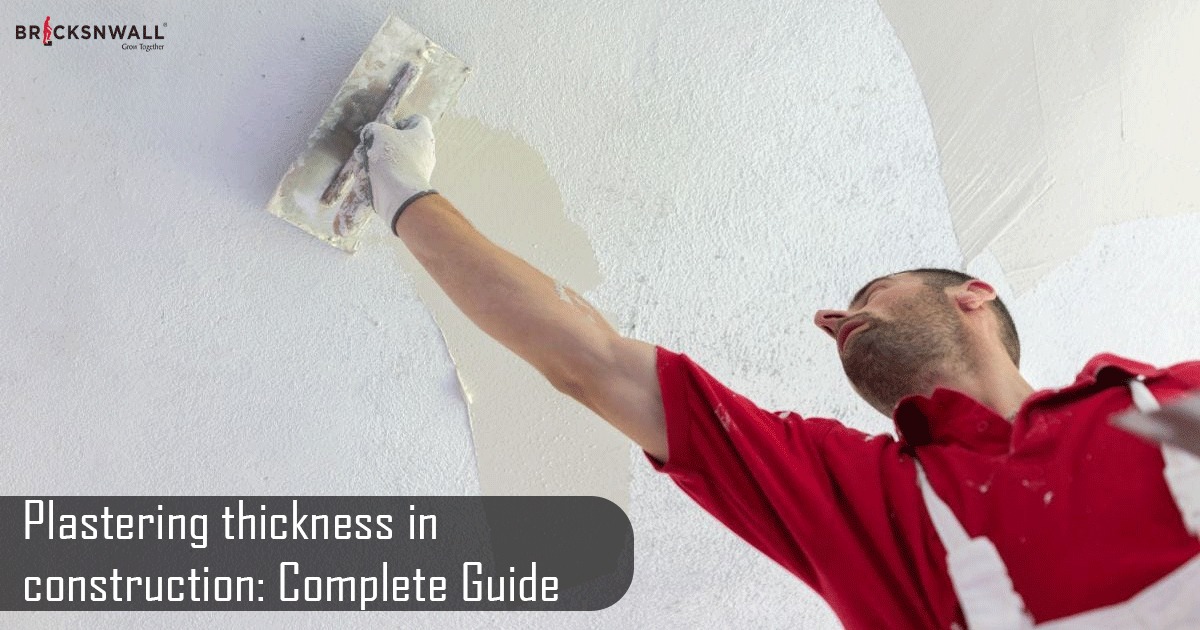Plastering thickness in construction: Complete Guide
Bricksnwall Trusted Experts

In construction, plastering thickness refers to the
amount of plaster put to the surface of walls, ceilings, or other structural
elements. Plastering is used to apply a smooth, even, and protective finish
coating to surfaces. Plastering thickness can vary depending on the type of
surface, the type of plaster, and the intended purpose of the plastering.
Plastering thickness can be classified into three
major types:
1. Base Coat or Undercoat Plastering: The first layer of plaster is placed directly to the masonry or brickwork surface. The thickness of the base coat can vary between 10 mm (0.4 inches) and 15 mm (0.6 inches), depending on surface flaws and the type of bricks or blocks used.
2. Second Coat or Skim Coat Plastering: Following the base coat, a second, thinner coating known as the skim coat is applied. This layer is intended to create a smooth and consistent finish. The skim coat ranges in thickness from 5 mm (0.2 inches) to 6 mm (0.24 inches).
3. Total Plaster Thickness: The total plaster thickness
is the sum of the base and skim coats. The overall plaster thickness typically
ranges from 15 mm (0.6 inch) to 20 mm (0.8 inch), however it can vary depending
on local construction practices, structural needs, and architectural choices.
It is crucial to note that the thickness of the
plastering can vary depending on the type of plaster utilised. For example,
classic cement-sand plaster and modern gypsum plaster may have different
suggested thicknesses.
Furthermore, specific plastering techniques, such
as roughcast or decorative plastering, might have an impact on the plaster
thickness.
Finally, the suitable plastering thickness should be chosen using building standards, structural soundness, and aesthetic criteria. To ensure adequate plastering thickness for your unique construction project, consult with qualified professionals and adhere to local building codes, guidelines, and advice.
Significance of Plaster Thickness
Plastering is more than just putting a layer; it is about achieving the proper thickness. Its thickness determines how long it lasts and how effectively it sets. Here's some insight on why thickness is important:
1. Historical Inspiration: Consider beautiful plaster ceilings from England's Elizabethan period as examples of the beauty and skill that plaster can provide.
2. Different Thickness Factors:
Surface and Mix Ratio:
The thickness of the plaster depends on the wall surface and the amount of
cement and sand.
External Challenges: Outside surfaces are more vulnerable to variables such as heat and rain, thus the plaster must be more durable.
Plaster Thickness Guidelines
When it comes to applying plaster, thickness is
important. Here's a breakdown of the required plastering thickness for various
surfaces in simplified terms:
Brick walls:
Plastering 12mm (approximately half an inch) is
typically applied to plain brick walls to achieve a smooth surface. Plastering
thickness can range from 15mm to 20mm, depending on the situation.
RCC surface (concrete):
When plastering over concrete surfaces such as RCC
ceilings or roofs, a thinner layer of 6mm or 10mm is typically employed.
Underside of RCC Ceiling or Roof:
The underside of a concrete ceiling or roof is typically covered in a 10mm layer of cement plaster.
Plain brick masonry:
A 12mm thick plastering is commonly applied to
brick walls with an even and flat surface.
Rough Side of Walls:
A 15mm layer of cement plaster is recommended for
the rough sides of 9-inch or 4.5-inch thick walls.
Dado with Cement Concrete Flooring:
To make a 'Dado' (a decorative design) with cement
concrete flooring, an 18mm plastering thickness of neat cement slurry is used.
Specific Design Requirements:
For certain design requirements, a two-coat plastering with a total thickness of 20mm may be applied to the rough side of a wall.
RCC Surface Areas:
A thinner 6mm layer of cement plaster can be added
to the RCC surface when it requires a protective layer, such as in specific
portions of the ceiling.
These standards ensure that plastering is done at the proper thickness for different surfaces, which improves the construction's durability and attractiveness.
Types of Plasters
Plaster, a useful tool for protecting and adorning interior walls, comes in a variety of forms. Some common ones are:
Cement Plaster: This plaster is
widely used and highly durable.
Clay Plaster: Known for its natural
characteristics, it is frequently picked for its environmental friendliness.
Gypsum Plaster: Known for its
flawless surface and short set time.
Lime Plaster: A traditional
alternative noted for its breathability and historical application.
Choose the Right Plastering Thickness.
To accomplish a high-quality plastering work, you must understand how thick the plaster should be on both the inside and outside of your home. Let us put it in simpler terms:
Interior plastering:
Plastering on the inside of your home typically
consists of a single layer.
The thickness of this inside plaster can range from
6mm to 12mm.
Exterior plastering:
Plastering your home's outer walls is done in two
layers, or coats.
The plaster thickness for the exterior can range
from 18mm to 20mm.
Knowing the plastering thickness details will help you ensure the proper finish for both the interior and exterior of your home.
Handy Tips For Successful Plastering
Achieving a Polished Plastering Result: If you want
to achieve that sleek plastering finish, here are some practical tips to
follow:
Begin with a Clean and Dry Surface:
Before you start plastering, make sure the surface you're working on is clean
and dry. This creates a strong base for the plaster to adhere to.
Choose a Sharp Trowel:
To guarantee a uniform application of plaster, use a sharp trowel. This tool
aids in the constant application of plaster across the surface.
Take it step by step. Do not rush it! Work in little parts at a time. This method allows you to focus on each piece while maintaining a consistent finish.
Allow Drying Time:
After plastering one piece, allow it enough time to dry before going on to the
next. This step-by-step drying technique helps to prevent accidents and keeps
the plaster intact.
Considerations for a Two-Coat System: If
you're utilising a two-coat system, let the first coat to completely dry before
applying the second coat. This patience produces a strong plastering outcome.
Finishing Touch with a Damp Sponge:
To complete the plastering procedure, use a damp sponge to smooth the last
coat. This improves the overall appearance and gives it a polished finish.
Remember, with a little attention and care, you can
easily create a professional-looking, smooth finish with your plastering
projects.
Plaster Thickness Guidelines Based On Industry
Standards
Plastering Thickness Regulations:
The IS code 2402: 1963 specifies the recommended thickness of plastering for
various types of construction work in India. This regulation establishes
criteria for the acceptable plastering thickness for various uses.
exterior Plastering Thickness: According
to IS code 2402: 1963, the recommended thickness for exterior plastering brick
walls is 15 to 20mm. This thickness protects and beautifies the building's
outside surface.
Internal Plastering Thickness:
For internal walls, the IS code recommends a plastering thickness of 10 to
12mm. This series provides a smooth and even finish to interior surfaces.
Ceiling and Concrete Plastering: The standard
plastering thickness for ceilings is 6mm. Similarly, the IS regulation suggests
a concrete wall thickness of 10mm. This plastering forms a protective coating
over these specific regions.
Plaster thickness varies depending on the type of
plastering. The recommended thickness for a single layer of interior plastering
is 10mm, 12mm, or 15mm, according to the IS code. Additionally, a
double-layered plastering of 18mm or 20mm (10mm base layer with an 8mm or 12mm
top layer) is proposed for external walls, with the goal of improving
durability and appearance.
Minimum and Maximum Limits: According to the IS code, the plastering thickness for brick walls shall not be less than 6mm. The lower limit is appropriate for ceiling plastering, but 10mm is the minimum thickness for concrete walls. The maximum thickness recommended for external plastering is 20mm, while double-layered plastering on outside walls is 25mm. These upper limits preserve structural integrity and retain an appealing look.
Conclusion
As a result, selecting the appropriate plaster kind and thickness ensures not only protection but also visual beauty for your walls. Plastering is more than simply a utilitarian step; it is an art form that adds to the solidity and beauty of your building.







